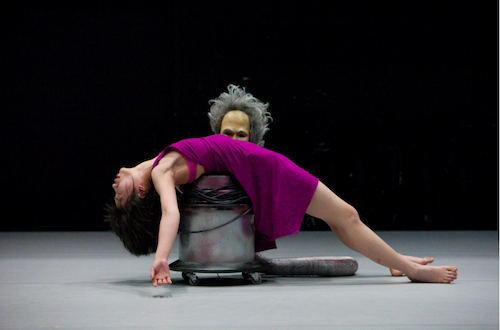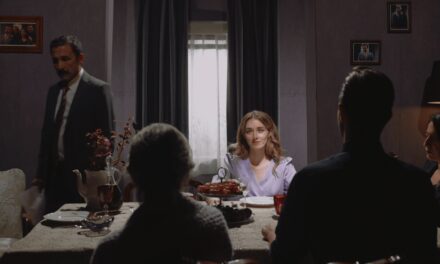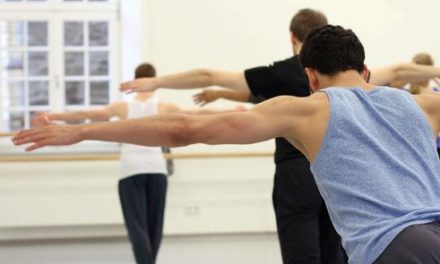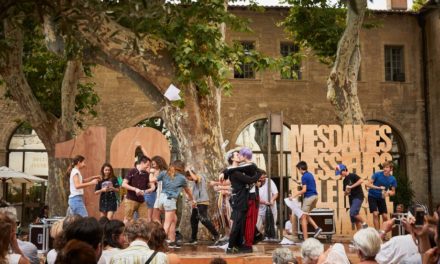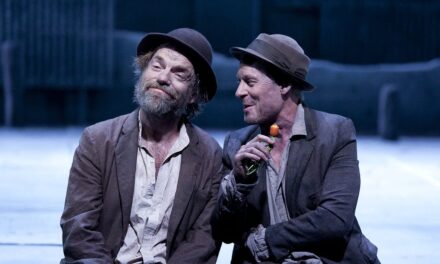The history of puppetry is full of supernatural bodies on stage that dramatically or subtextually represent their quest of coming to life and gaining autonomy from their masters. A puppet’s performance often reflects on its condition of existence: How does a random object become an animated body on stage? This practical and theoretical question energizes South Korean artist Geumhyung Jeong’s (b. 1980) body of work. Jeong extends the possibilities of puppetry by choreographing her entire body as her animation technique. Moreover, she explores the various dimensions of the object’s liveliness by way of sexuality. In fact, in Jeong’s exploration of animacy, this stage life of the object always already involves intimacy and sensuality. She crafts and manipulates her performing objects that range from simple masks to dummies to machines, embraced carnally with them in the double entendre of playing with control. Reflecting on the six performances Jeong created between 2008 and 2019, I am repeatedly reminded that there is no anima, no life, and no agency for objects devoid of sexual being.
Love
In her first evening-length work 7ways (2009, Seoul, which originally premiered in 2008), Jeong creates makeshift puppet forms with simple objects and household items on stage. She attaches masks, mannequin parts, and large pieces of fabric on her body or on machines to bring to life a series of supernatural figures with distinct anatomies and characteristic movements. In a series of assemblages that consist of Jeong’s body parts with objects, we see vignettes of sensual encounters between these unearthly creatures and Jeong, who at times appears inert or utterly distant herself. Without ventriloquism or any other storyline, what makes these multifarious characters come to being convincingly is the choreographic expression of their sexual appetites, delivered by the unique movement quality Jeong explores with them.
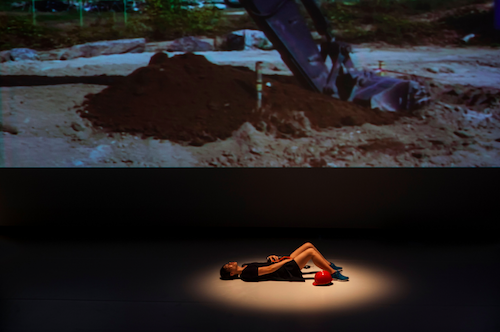
Oil Pressure Vibrator @ Karolina Miernik
Some of these horny figures appear in the videos of Oil Pressure Vibrator (2008, Seoul), Jeong’s subsequent stage work. In this lecture-performance, Jeong recounts her search for sexual independence, which culminates in a love affair with a hydraulic excavator. Her lecture is entirely supported by the video clips she plays on her laptop, and with no performing object on stage except for a toy excavator she briefly runs over her body. However, the performance does double duty as Jeong’s manifesto of puppetry: The videos show her backstage process of making and animating the materials from 7ways, presented in her narrative as her sexual partners prior to the excavator. Consequently, in the challenging path to consummate her love with a real excavator, her certification process to operate the engine is chronicled as a choreographic mission for her body to become one with the machine. Despite this apparently personal narrative, Jeong’s conduction of her video clips and lecture is as precise and depersonalized as classical puppetry.
In a chiastic way, 7ways and Oil Pressure Vibrator layout how objects can move to conjure up their incarnation, which immediately translates into their expression of an alien kind of sexuality. What sexuality might mean to us makes all the difference here. In these early pieces, Jeong’s collaborators on stage do not represent or move in human or animal likeness. Jeong does use masks with human faces, creepy looking and masculine heads, a female showroom mannequin; certainly, the excavator in Oil Pressure Vibrator evokes a fully formed and phallic partner. Indeed, her later work Fitness Guide (2011, Seoul) continues her investigation on how to pervert the contradictions of human embodiment through machines. Exemplified in her swaying rhythm on an elliptical trainer, Jeong’s work-out with the exercise machines, some of which are modified with human heads, seems more like making out. But the choreographic assemblages Jeong generates with objects or machines always manage to mock or entirely escape human anatomy, genitality, or gender roles, sometimes all at once.
In the most famous episode of 7ways, Jeong performs with a drum-type vacuum cleaner, its hose attached to an old man’s head with a wide-open mouth. Putting on a pink dress, she lays over the barrel in a balletic recline. Slowly, her partner raises its long, tubular neck (operated by Jeong’s upstaged hand) and hungrily gazes at her. What follows is the creature’s visible effort to move Jeong around, who in turn seems lifeless like a plastic doll the whole time. Tumbling her back and forth in impossible positions, the machine’s desire comes to an irresistible point; it literally gets turned on and begins kissing her with its strong suction. With each kiss, Jeong’s chest undulates and her legs bounce up in the air as if to score her partner’s success, parodying, with some sympathy for the pathetic creature, the domestic fantasy of all-obeisant and ever-pleased wife. Or in Fitness Guide, what makes the audience think that Jeong’s slowly pumping air into a red balance ball looks rather… lesbian, despite its surface innuendo?
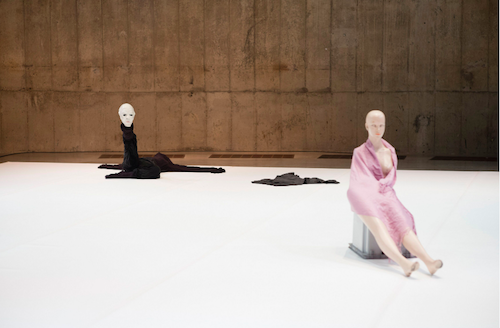
7ways @ Lewis Ronald
As much as Jeong has the precision of a puppeteer, her being the single human on stage does not make her more of a master-subject in relation to the objects. She manipulates her own body like any other object in order to animate her stage/sexual partners, a process she fictionalizes as “dividing herself in two” in Oil Pressure Vibrator: She either projects her persona on one of the objects on screen or appears receptively passive toward the spirited figures she forms with her body parts and controls undercover. Any recognizable performance of a desiring subject on her part would run the risk of turning the objects into fetishes, which she carefully avoids by interacting with her material as impersonally and in an as detached as possible way.
With the choreographic re-disciplining of puppetry as the bedrock, none of these sexual animations are directly allusive to human sex, despite the objects’ promiscuity that we can feel immediately. Nor do they reproduce heteronormative regimes or leave them intact. As a female puppeteer with quite queer object-partners, Jeong not only reverses the sexual economy of the Pygmalion myth twice over as she entwines her body with matter while retaining her objective manner. She also irreverently reformulates what sexuality, or being a sexual subject-object, can mean and look like. Over and over again, in the most reserved aesthetics of obsession possible.
Labor
Or maybe the obsession is ours, in the audience’s ways of seeing. If in her early works Jeong’s fantastical assemblages of machines, objects, and body parts explore sexual autonomy or an anarchism of sexuality, in her later and more “medically oriented” pieces CPR Practice (2013, Munich Spielart Festival) and Rehab Training (2015, Seoul), she troubles the heteronormative politics of sexuality by playing with the audience’s sense of reality and illusion. With masculine dummy models and a whole inventory of medical apparatus on stage, she performs health drills that make use of everyday scenarios. Jeong simply introduces sexuality into these scenarios, which is ordinarily tucked away for the sake of public morality. While finding a believable embodiment and motion in the object is still important for Jeong, she now interrogates how the very illusion of the object’s animacy is formed, broken, and re-formed on stage. Accordingly, Jeong’s politics of sexuality concerns more directly the fraught nature of desire, consent, and relationality, not only between humans and objects but also between genders.
CPR Practice has been the most straightforward of Jeong’s pieces, dramaturgically speaking. The foreplay between a woman and a male dummy is soon disrupted when the former realizes that her flaccid partner’s lack of response to her advances is due to not his apathy, but to his lack of breathing. Unfazed, Jeong runs to the first aid box in the corner of the performance space and brings in a huge repertoire of tools and techniques to resuscitate the dummy—an automated external defibrillator, an electrocardiogram, numerous tubes for artificial ventilation—employing them one after another between each chest massage. The choreographic programming of this singular objective, the practice of bringing back to life, demands Jeong, deadpan and procedural, to rerun the steps with an increasing number of gadgets, actions, and cacophonic signals. Bordering on physical comedy, the sense of failure builds up with each machine introduced to the resuscitation process, both on the lifesaver’s part in her breathless fatigue, and on the dummy’s part in his unrecoverable loss of desire/life.
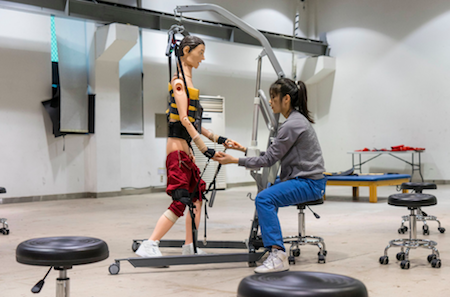
Rehab Training @ Mingu Jeong
Although they are not created as a diptych, in retrospect, it was illuminating to watch CPR Practice in Mannheim’s zeitraumexit in October 2018, a few months before Rehab Training’s six-show run at Kunstenfestivaldesarts 2019. CPR Practice hovers between an emergency drill, an adventurous masturbation, and an adrenalized sexual fantasy between two partners. Jeong takes these ambiguities and expands them over the detailed structure of her 160 minutes long rehabilitation operation in Rehab Training. If CPR Practice is a failing practice to revive a dummy/man/masculinity as well as an intentional practice of failure in puppeteering, Rehab Training makes Jeong teach the dummy to regain its movement skills, including sexual ones.
Rehab Training, Jeong tells me in our conversation in Brussels, takes off from the acceptance that an object’s animation is an insurmountable problem and explores what emerges when the perfect illusion of autonomous movement is abandoned. The physical therapy equipment and mobility aids that fill the performance space look like a super-sized string puppet theatre, where the dummy is explicitly moved by a human. The first two hours of the piece unfold as the slow process of getting the dummy on its feet to walk and making it use its upper body to solve simple and repetitive manual tasks. What we actually watch for the most part is Jeong establishing the material conditions of these exercises, tying the dummy in various harnesses, placing it in walking lifts, attaching rods and strings to its limbs one by one. While the dummy waits still, this extensive and exhaustingly elaborate labor of care imposes its own choreography on Jeong’s body.
Despite this realistic premise of the performance, the fact that this is a meticulous training of motion rehabilitation a woman rehearses on a dummy model (the sensation of a living body re-learning to move, albeit minimally and clumsily), interjects its fascinating illusion on to the scene. As the dummy gets more mobile, its successful efforts get rewarded by Jeong’s long stares, who sits across to control its hands with connecting rods. Fast-forwarding some other tedious arrangements that dissipate the erotic tension, we see the two swing in each other’s arms, entangled in harnesses and lifts. For when life enters the dummy, as per Jeong’s performative theorizing of animation, so does sexual desire.
Jeong admits that once the animation is posited as a difficulty rather than a skillful execution, her task becomes precisely to create the performance of an imperfect movement. Through this complex choreographic task, Jeong fully exploits the “alternating belief and unbelief in the puppet’s autonomous existence” that puppetry scholar Penny Francis locates in the form’s fundamental structure: “All but the most naïve spectators will find themselves now convinced, now unconvinced that the creature before them has life; they will focus on the puppet, then the manipulator and the method of control (when the manipulator is visible), and back again to the puppet.”[1.] Our gaze oscillates between the dummy and Jeong increasingly as time passes, as the rehab exercises demand larger motions in her upper body to transfer more delicate groping gestures to dummy’s hands. The more her labor physically intensifies, the more charged her interaction gets. But because of the flickering sense of life in the dummy, her love seems to be reciprocated rather than a solipsist fantasy.
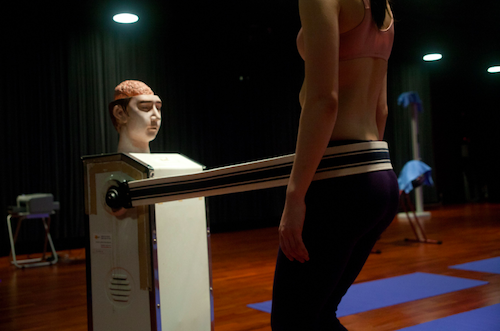
Fitness Guide @ Youngkyo Choi
Jeong wields what Francis describes as the puppetry’s “double vision” by expanding and exposing her methods of movement control over multiple performances. Rehab Training alone is based on the variations of getting another body to controlled movement. Carrying this idea further into sexual politics, Jeong apparently swaps the patriarchal gender roles. However, the power dynamics between the subject female and the objectified male shifts incessantly and equivocally, for Jeong’s score of commanding over another body is at the same time a demanding choreography of taking-care. Moreover, the introduction of sexuality does not so much objectify the object back again to a fetish, but it allows Jeong to transform her labor of care into the dummy’s labor of love with Jeong as its object—at least this is the extended kink that Jeong’s trainee-character gets her kick from. Complicating our perception of life as the projection of desire and transference of consent onto things, Rehab Training locates sexual and corporeal agency somewhere in between objectification and labor for all parties involved, object or human, female or male. Thus, it demonstrates what animacy has in common with pleasure and power: it finds itself truly in the middle, hanging at the center of that oscillating gaze and never landing on one singular, hegemonic entity.
Loop
Jeong’s latest performance-installation Homemade RC Toy renders this understanding even more explicit. Commissioned by Kunsthalle Basel and opened in May 2019, Homemade RC Toy foregrounds Jeong as the maker of hand-made remote-controlled machines. Displayed at the upper floor gallery of Kunsthalle Basel, the toys in the title of the piece are five quadruped machines of dummy parts attached to an aluminum frame that carries the motor, a basic computer motherboard, and wheels. Even without moving, their outspread arms and legs over the floor evoke the sense that they are ready to get up or surge forward at any time. At the gallery’s perimeter, we see the parts of these machines displayed on a splash view, accompanied by six single-channel videos shot inside the same gallery. Each screen shows a different step in the machines’ construction, informs about the materials used, and gives us a glimpse of the labor that goes into making and moving them, with Jeong drawing the specifics of their construction in a diagram, assembling the pieces, and testing and adapting their range of motion.
In the live performance, we get to see the full range of how these dummy-machine hybrids move in space as Jeong, naked and lying on the floor like her toys, operates the controller buttons on what would be the nipples and genitals of the figures. With her careful touch of the machine’s button, a second toy across the performance area slowly moves forward. What looks like an odd foreplay between Jeong and the machines carries on as each toy gathers in the center of the gallery, controlled by the signals of another toy that Jeong activates with her caressing hands and lips. Halfway through the performance, as these crawling mutant automatons are closing down on her and are moving their limbs quite haphazardly, Jeong’s play with toys turns into a choreographic task of finding room for herself. Controller and controlled at the same time, all the bodies on the floor are overwhelmed by what could be the climax of this programmed orgy. Then they turn back to their beginning position, one after another, in a chain-reaction until the last toy sends the backward-motion signal to the first.
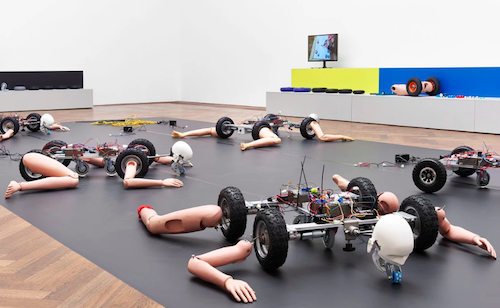
Homemade RC Toy @ Philipp Hänger / Kunsthalle Basel
Thanks to their quirky anatomy of dummy parts that are assembled from wheels and basic robotics, Jeong’s machines are performing objects not only when they are activated, but maybe more so when they are passive, throbbing with their grotesque potential. Unlike her choreographic pieces for theatrical context, the complexity of situations between human and nonhuman or subject and object is much pared down here, with no transformation in the relationships from beginning to end but a single loop that shows exactly what it shows: a simple play/execution between the girl and the toys that we know she made. We know she made them because the videos perform Jeong as the DIY hacker immersed in her industrious process, just like the videos in Oil Pressure Vibrator a decade ago. Next to the closed circuit of the toys’ sensual play stands the intricate labor it takes to design and construct these domestic delights. While the single-cycle orgy among the toys and Jeong is limited to live performance, the hacker’s manufacture continues endlessly on the screens.
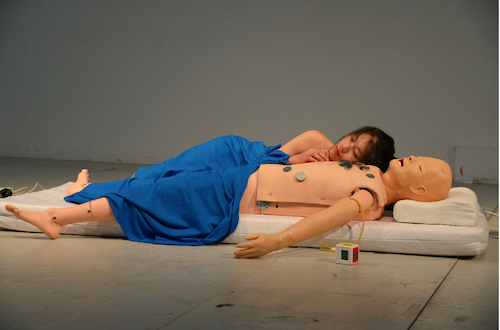
CPR Practice @ ZTS/Christian Altorfer
Jeong has been collecting objects—dummies, sex toys, organ-like machine parts, home utensils, medical appliances, grooming products—that oddly anticipate the fetishistic celebration of body and health today, as she showcased with a theatrical dramaturgy throughout her exhibitions “Private Collection” at Atelier Hermès (2016, Seoul), “Private Collection: Unperformed Objects” at Delfina Foundation (2017, London), “Private Collection: Rearranged Objects” at the 9th Asia Pacific Triennial of Contemporary Art (2018, Brisbane), and “Spa & Beauty” (2017, commissioned by Tate Modern) that traveled to cities such as Seoul, Berlin, Athens, and Madrid. [2.] With hindsight, Jeong’s exhibitions of still objects hint at her method of collecting practices that she performs on stage as her animation technique (such as operating an excavator, performing CPR, implementing rehab routine, coding in Arduino). Through this collection of repetitive practices, she theorizes the choreographic nature of performing objects and how to make herself disappear as a visible manipulator in varying degrees of self-objectification. She vanishes in love—or in labor, just like she went on and turned the exhibition space into her craft workshop for the newer version Homemade RC Toy, entitled Small Upgrade (September 2019, Ekaterinburg) for the 5th Ural Industrial Biennial of Contemporary Art.
Within a single piece, across works, between contexts, Jeong always takes her time and layers the performance through repetitions. She thus opens the inner mechanism of animation, which at times deliberately edges on failure. She gives the audience the room to choose whether they want to watch a human subject and a freakish or human-ish object in an onanist ritual, or an encounter between desiring bodies that meet each other with mutual plasticity and effort. However one sees it, the thrill of Jeong’s animation is not bound by the sole illusion of anthropomorphic life in an object, but it is generated by the co-transference of energy between object and character, between materiality and movement. What we can consider as her body of work, then, is equally about this circular labor, the self-reflective and methodic investigation of moving-towards-movement undertaken by Jeong and her stage partners evenly, in rapture and on repeat.
- Penny Francis, Puppetry: A Reader in Theatre Practice (New York: Palgrave Macmillan, 2011), 22.
- Art critic and curator Kim Junghyun captures the dramaturgical element in Jeong’s object exhibitions as a site-specific approach to the white cube in her review of Atelier Hermés show, https://www.theartro.kr:440/eng/features/features_view.asp?idx=521&b_code=12
This article was originally posted at Etcetera and has been reposted with permission. To read the original article, click here.
This post was written by the author in their personal capacity.The opinions expressed in this article are the author’s own and do not reflect the view of The Theatre Times, their staff or collaborators.
This post was written by Eylül Fidan Akıncı.
The views expressed here belong to the author and do not necessarily reflect our views and opinions.

